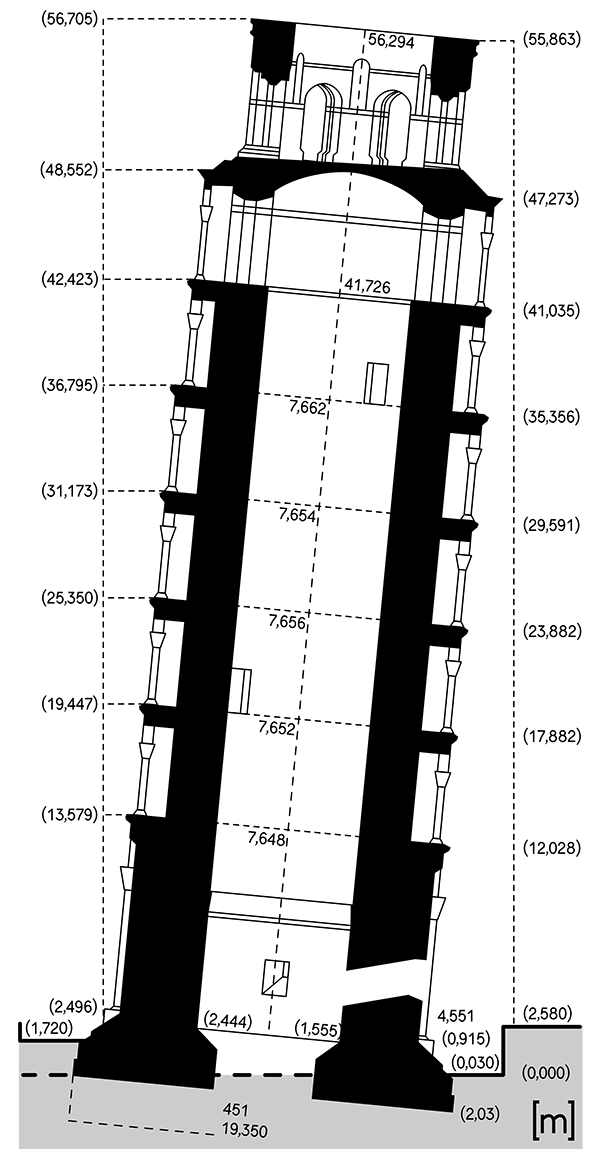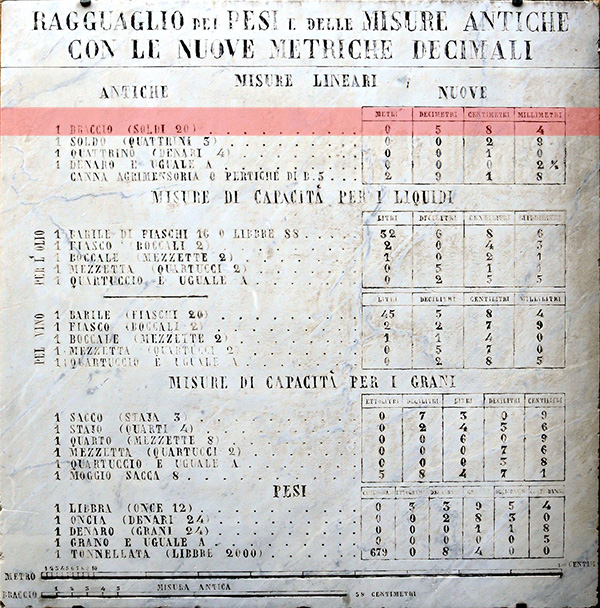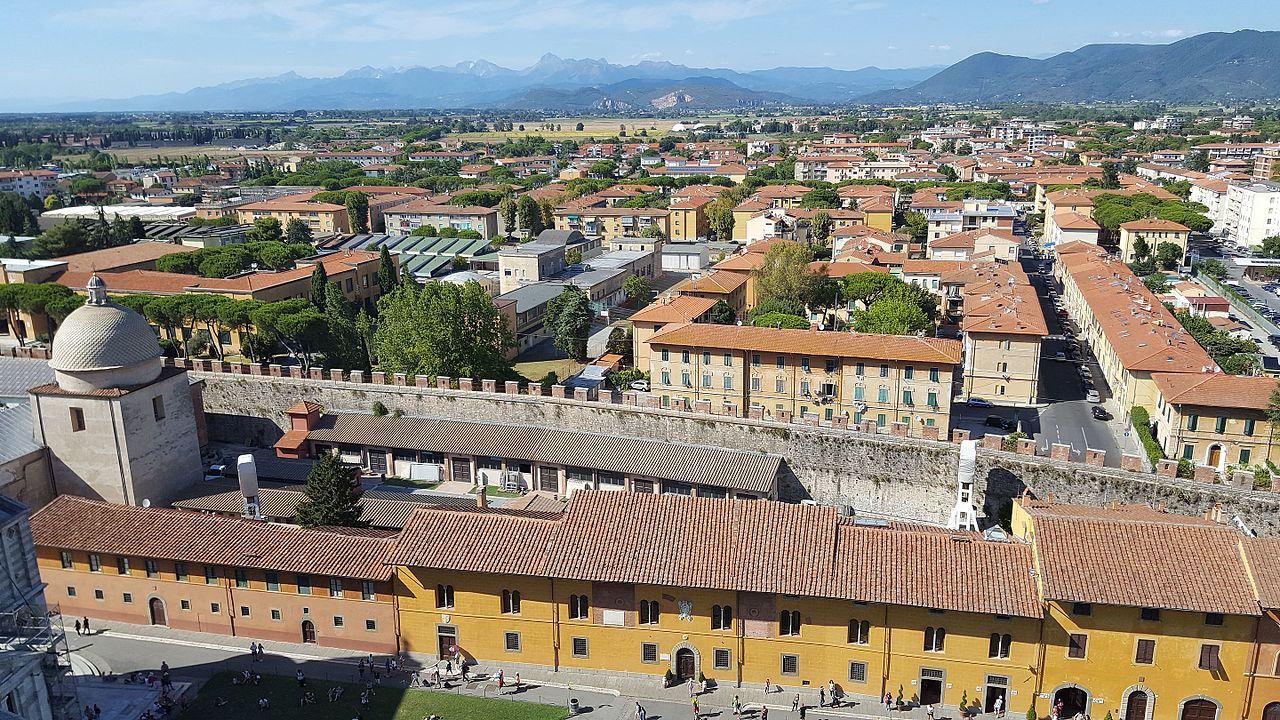This is probably one of the most asked questions... to the point that Google gives a straight answer: 57 meters.
However, you should not always believe what you are told and - just for this time - you should not trust even Google.
Why?
...because GOOGLE IS WRONG on this one: the Leaning Tower of Pisa is NOT 57 meters tall...

The question itself leaves a bit of room to interpretation: how do you measure the height of something that is not straight?
The top of the Tower has a high point and a low point and so does its base.
Should we measure the height from the ground?
...or from the bottom of the base?
The height of 56.7 meters (rounded by Google at 57m) is measured from the lowest point on the base to the highest point on the top.
At its lowest point, the Tower measures 55.9m.
However, the Tower is taller than that!
Since its foundation is sunk into the ground (about 2 meters deep at the lowest point) the total height of the Tower would be 58.36 meters.
This corresponds EXACTLY to "100 braccia pisane".
This is a little-known fact that deserves to be mentioned.
 
The Internet is full of good articles on the Tower - just to mention one "13 Straight Facts About the Leaning Tower of Pisa" by Michael Arbeiter - covering a number of curiosities on this unique monument. However, none of them reports the fact that the apparently random height of the Tower corresponds in fact to a very precise measure.
#Google is #WRONG! ...the correct height of the Leaning Tower of Pisa is 58.36 meters.
The "braccio" (Italian for "arm") is an ancient measure of length, an "arm" measure to be exact.
This measuring system was in force in Tuscany around the year 1000 (at the time when the Tower was built).
One arm length was 58.4 cm, as shown in the image below (highlighted in pink).
The stone represented in the image is located on a market square in Tuscany and its purpose was to serve as a reference for merchants and traders while doing their business.

100 arms was a big deal
The Baptistry nearby the Tower is also 100 arms tall at its highest point.
...so, the full height of the Tower of 58.4 meters is not random at all. They wanted to make it 100 arms tall... and so they did.
Yes, it really looks like that, at the time, 100 arms was a big deal!
Of course, that did not come easy or "straight" as the building started to sink when they got to the third level in 1178.
Who built the Tower needed to make several corrections along the way but the target height of 100 arms was kept and reached with a compromise: measured from the foundation plan and not from the ground level.
Did you know the Leaning Tower of Pisa is exactly 100 "Tuscan arms" tall?
Often one needs to make compromises in order to achieve big goals. By the middle of its construction time, getting the Tower to stand was the primary goal and its height was not that important anymore.
Today you can go inside the Tower and climb up to the top... it doesn't matter much if that is 55 or 58 meters.
All the monuments in the Square of Miracles (the Tower, the Baptistry, the Cathedral, the Museum of the Sinopie, the Monumental Cemetery) are open to the public for an entry fee. The ticket can be bought on site or on the internet.
A spectacular view
A height of fewer than 60 meters might not sound much when compared to other famous towers.
For comparison, the Eiffel Tower in Paris is over 300 meters tall and the Empire State Building in New York reaches 380 meters... nevertheless, the view from the Tower is truly spectacular!
What makes the view in Pisa so breathtaking is the fact that the surrounding buildings are way shorter than the Tower.
The buildings around the Square of Miracles are 2 or 3-story houses and they reach a height of 15 meters at best. This means that the Tower is over 3 times taller than the average building around it!
Moreover, the fact that the Tower is "not too high" allows admiring the details of the red roofs (in perfect Tuscan style) and the intricated streets of the beautiful medieval Town.


The Eiffel Tower is so high that one cannot admire details of the surrounding buildings and can barely see the people on the ground...
The Empire State Building is surrounded by buildings that are not much shorter...
They both offer totally different viewing experiences.
There are no nuts and bolts in the Tower, just plain and simple marble stones!
On top of that, those are modern constructions and they cannot be compared with the Leaning Tower of Pisa. In fact, while the first two are mostly made out of steel, the Leaning Tower is entirely made out of marble!!!
There are no nuts and bolts in the Tower, just plain and simple marble stones... it is almost a miracle it is still standing.
It depends on where you come from
While in the year 1200 they would have measured Tower in arms, today we use different systems... but not everyone uses the same!
Even nowadays, length and mass are measured in different ways around the globe.
To make everyone happy, here is the true height of the Tower in the different units of length:
- ARMS - the Leaning Tower of Pisa is 100 arms tall;
- METERS - the Leaning Tower of Pisa is 58.36 meters tall;
- FEET- the Leaning Tower of Pisa is 191.47 feet tall (or 191 feet 6 inches);
- YARDS - the Leaning Tower of Pisa is 63.8 yards tall.
Other relevant measures
Finally, a few more numbers about the Tower to put curiosity at rest:
- Number of floors: 8;
- Height of every floor (from 2 to 8): 10 Tuscan arms (5.84m);
- External diameter at the base: 15.48 meters;
- Internal diameter at the base: 7.368 meters;
- Thickness of walls at the base: 4.1 meters;
- Diameter at the foundation: 19.58 meters;
- Circumference at the base: 48.6 meters (100 Tuscan feet);
- Mass: 14.453 metric tons.



